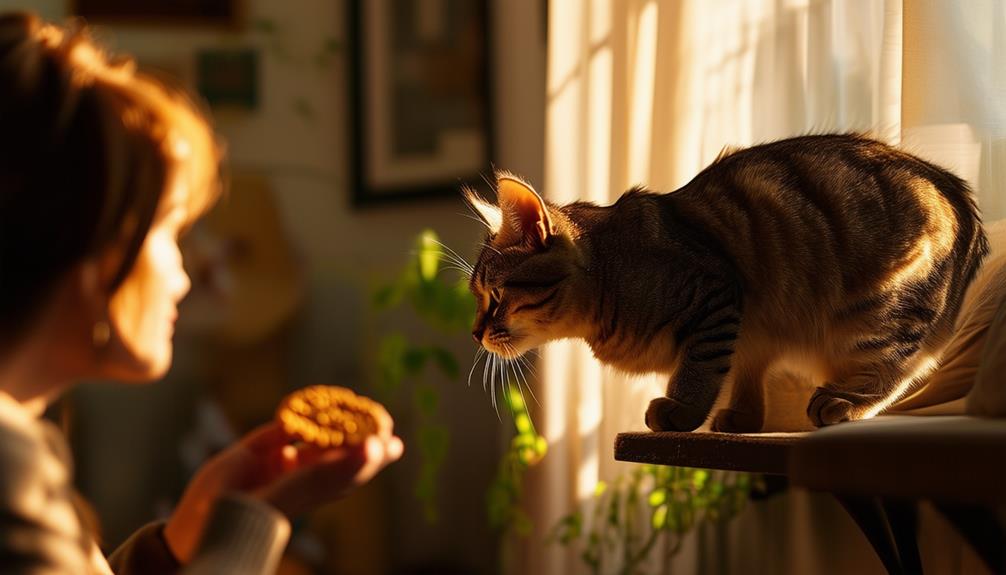The Power Dynamics of Cat-Human Interaction: Who's Really in Control?
When you consider the power dynamics between cats and humans, it’s easy to assume that you, as the human, hold the reins. However, the reality is more nuanced.
Cats, with their subtle yet assertive behaviors like face rubbing and tail positioning, often tip the scales in their favor.
Meanwhile, you influence the relationship through routines and boundaries.
But who’s truly in control?
The answer lies in the intricate dance of communication and territorial claims.
As you explore how both parties navigate this relationship, you’ll find that the lines of control are often blurred, leaving much to ponder.
Historical Context of Cat Domestication
The domestication of cats dates back to ancient civilizations where they thrived as household members and pest controllers.
You might be surprised to learn that early societies, such as those in Egypt, revered cats not only for their practical abilities to control vermin but also for their perceived mystical qualities.
Cats were often depicted in art and mythology, symbolizing protection, fertility, and even divinity.
As you explore deeper into history, you’ll find that cats shifted from wild animals to cherished companions over thousands of years.
Their ability to adapt to human environments likely made this change easier. In agricultural communities, cats played a significant role in safeguarding food supplies by hunting rodents, which helped them earn their place within homes.
Understanding this historical context helps you appreciate how deeply rooted the relationship between humans and cats is.
This bond has evolved but remains significant today. Cats maintained their independence while forming mutually beneficial relationships with humans.
Their enigmatic nature and hunting prowess earned them a unique status, blending utility with companionship.
Behavioral Insights Into Cat Dominance
Ever wondered how cats establish their dominance within a household?
Cats use a variety of behaviors to assert their position. You might notice your
This action marks territory with scent glands located on their face, signaling ownership and dominance.
Cats also use body language to communicate their status.
A dominant
This confident posture signifies control. Additionally, cats often engage in play fighting.
While this can seem harmless, it’s their way of testing boundaries and establishing a pecking order.
Vocalization plays a significant role too. A dominant
These vocal cues aren’t just random noises; they’re purposeful actions aimed at communicating dominance.
Lastly, watch how your
Human Influence on Cat Behavior
Understanding your
When you consistently feed your
Providing interactive toys and engaging in play sessions allows your
Your tone of voice and body language also play significant roles.
Speaking in a calm, reassuring tone can soothe an agitated
When you pet your
Consistency is key. If you set boundaries, like keeping them off the kitchen counters, enforce them gently but firmly.
Mixed signals can confuse your
This mutual understanding helps in creating an environment where your
Communication: Who’s Leading?
In the intricate dance of
Cats have a unique way of expressing their needs and emotions through vocalizations, body language, and even scent markings.
You might think you’re calling the shots, but often, it’s your
Consider how your
These signals are not just random; they’re carefully crafted to elicit specific responses from you.
By understanding these cues, you can better interpret what your
Here’s a quick guide to some common
| Behavior | Possible Meaning | Your Response |
|---|---|---|
| Meowing | Needs food/attention | Check food bowl, spend time with them |
| Purring | Content/happy | Continue what you’re doing, gentle petting |
| Tail Twitching | Agitated/excited | Give space, observe for more signals |
Territorial Control and Space
Cats are natural territorial creatures, and their control over space greatly impacts their relationship with you.
When a
This space can be a favorite window perch, a comfy spot on your bed, or even just a particular corner of the living room.
Recognizing and respecting this territorial behavior is key to maintaining a harmonious relationship with your
You might notice that your
This action leaves their scent, marking the territory as theirs.
By respecting these marked boundaries, you’re acknowledging their need for control over their environment.
Cats feel more secure and less stressed when they’ve a defined territory.
On the flip side, your
They might avoid or tread lightly in spaces where your scent is strongest. This mutual respect creates a balanced dynamic in your shared living space.
Providing your
Ultimately, understanding and respecting your
Emotional Bond and Dependency
Establishing a strong emotional bond with your
This relationship goes beyond just feeding and grooming; it’s about understanding each other’s emotional needs.
When you spend quality time with your
Your
- Following you from room to room
- Seeking your attention through gentle paw taps
- Curling up next to you when you’re feeling down
These actions indicate that your
This emotional exchange creates a balanced dynamic where both parties benefit.
However, it’s crucial to acknowledge that this reliance requires your active participation.
Regular playtime, attentive petting, and responding to their needs build a deeper connection.
You might also notice that your mood influences your
Conclusion
Ultimately, the power dynamics between you and your
By recognizing your
Communication through body language and vocal cues plays an essential role in determining who leads at different times.
Remember, a harmonious interaction relies on both parties adapting and responding to each other’s needs, fostering a strong emotional bond and a peaceful coexistence.






